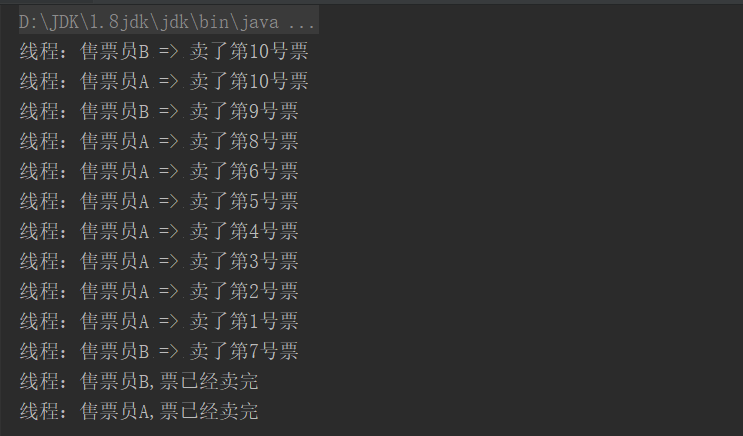1.多线程的实现
多线程有两种实现方式:
1.1.继承Thread类 =>示例:A a=new A(); a.start();

1.2.实现Runnable接口 =>示例:A a=new A(); new Thread(A,自定义线程名称).start();

其实Thread和Runnable都实现了run方法,这种操作模式其实就是代理模式
获取当前线程名称:Thread.currentThread().getName()
调用线程是thread.start(),真正执行线程是 thread.run()
具体代码:
1 /**
2 * 继承Thread类
3 * @date 2019/3/29 11:19
4 */
5 public class SimpleThread extends Thread{
6
7 @Override
8 public void run() {
9 super.run();
10 Thread thread = Thread.currentThread();
11 System.out.println("Thread =>当前执行的线程为:"+thread.getName());
12 }
13 }
14
15 /**
16 * 实现Runnable接口
17 * @date 2019/3/29 11:28
18 */
19 public class SimpleRunnable implements Runnable {
20
21 @Override
22 public void run() {
23 Thread thread = Thread.currentThread();
24 System.out.println("Runnable =>当前执行的线程为:"+thread.getName());
25 }
26 }
27
28 public class TestMain {
29
30
31 /**执行线程示例1*/
32 private static void callSimpleThread(){
33 int index=10;
34 for (int i = 0; i < index; i++) {
35 Thread thread=new SimpleThread();
36 thread.start();
37 }
38 }
39
40 /**执行线程示例1*/
41 private static void callSimpleRunnable(){
42 int index=10;
43 for (int i = 0; i < index; i++) {
44 SimpleRunnable simpleRunnable=new SimpleRunnable();
45 new Thread(simpleRunnable,"Runnable-"+i).start();
46 }
47 }
48
49 public static void main(String[] args) {
50
51 callSimpleThread();
52
53 callSimpleRunnable();
54 }
55
56 }
2.多线程安全问题
2.1线程不安全示例
多线程最容易产生的一个问题就是线程安全问题,下面使用一个卖票的例子来体现。
场景描述:现在有两个售票员,一共卖10张车票
1 public class SellTicket extends Thread {
2
3 private static int NUMBER = 10;
4 public SellTicket(String name) {
5 super(name);
6 }
7
8 @Override
9 public void run() {
10 String s = "线程:" + Thread.currentThread().getName();
11
12 while (NUMBER > 0) {
13 int i = NUMBER--;
14 System.out.println(s + " => 卖了第" + i + "号票");
15 }
16
17 System.out.println(s + ",票已经卖完");
18 super.run();
19 }
20
21
22 public static void main(String[] args) {
23
24 SellTicket thread1 = new SellTicket("售票员A");
25 thread1.start();
26
27 SellTicket thread2 = new SellTicket("售票员B");
28 thread2.start();
29
30 }
31
32 }
执行结果如下:
我们发现售票员A 和售票员B都卖了10号票,这就是线程不安全导致的结果

2.2线程不安全解决方法
方案一:使用同步代码解决
格式:synchronized(锁对象){需要被同步的代码}
锁对象可以为this锁,也可以自定义对象锁
方案二:使用同步函数解决
同步函数就是使用synchronized修饰一个函数
下面采用同步代码块解决
1 public class SafetySellTicket extends Thread {
2
3 private static int NUMBER = 10;
4
5 @Override
6 public void run() {
7 String s = "线程:" + Thread.currentThread().getName();
8
9 while (NUMBER > 0) {
10 synchronized (this) {
11 if (NUMBER > 0) {
12 int i = NUMBER--;
13 System.out.println(s + " => 卖了第" + i + "号票");
14 } else {
15 System.out.println(s + ",票已经卖完");
16 break;
17 }
18
19 }
20 }
21 super.run();
22 }
23
24
25 public static void main(String[] args) {
26
27 SafetySellTicket thread1 = new SafetySellTicket();
28 thread1.start();
29
30 SafetySellTicket thread2 = new SafetySellTicket();
31 thread2.start();
32
33 }
34
35 }